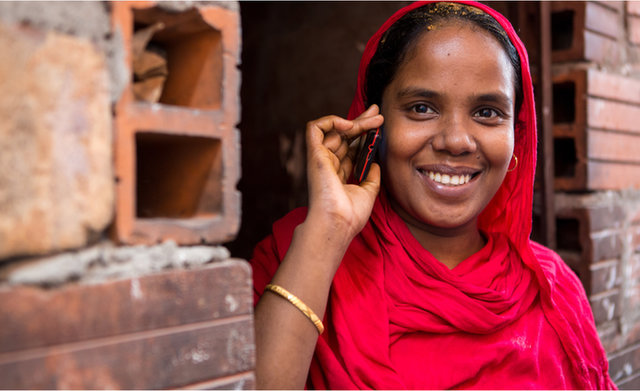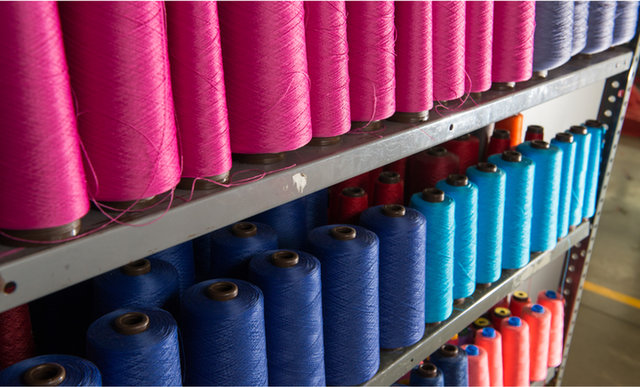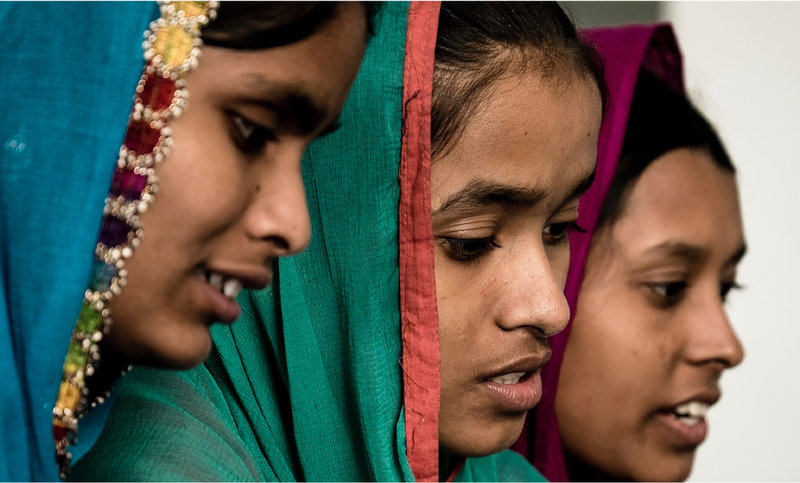Highlights: Analysing our impact
KPIs
Key performance indicators (KPIs) are useful metrics to track progress, make adjustments to improve effectiveness and get closer to achieving programmatic goals. But KPIs don’t always tell the full story, especially when it comes to systemic change. Laudes Foundation is transitioning to a hybrid model that combines quantitative and qualitative evidence, allowing us to better assess our progress towards systemic change.
Graph colour key
Sustainable Cotton
Number of farmers adopting organic cotton farming
Our partners worked with over 55,000 smallholder farmers in five countries; their support enabled farmers to build capacities in organic cultivation, strengthen their collective action efforts through farmer institutions, and access markets that paid fair prices.
Number of hectares under sustainable cotton cultivation
Over the last five years, our partners supported farmers in bringing over 50,000 hectares of farm land across India, Pakistan, Tanzania, China and Brazil under organic cotton production. Effective community-level institution building and creation of market linkages has driven this growth.
Working Conditions
Number of workers benefitting from improved working conditions and wages
Over the past five years, and together with our partners, we have learned a great deal about how to employ strategies that achieve greater impact. We have stopped supporting factory-by-factory initiatives and pilot programmes in which the path to scale was not clear. This has helped our partners to double the number of workers directly benefitting from our grants.
Number of disclosure and transparency mechanisms used by the industry
The landscape for transparency initiatives in 2019 has greatly changed since we began our work in 2015. While parts of the industry may have felt threatened by transparency in 2015, today more and more industry actors embrace transparency as a path towards accountability and as a way to level the playing field. This is why we were able to surpass our original target.
Number of collective bargaining agreements
Workers and their representatives continue to work in environments that are unfavourable to freedom of association and collective action. By employing new strategies, such as exposing factory conditions publicly and gaining media attention, our partners in India, Indonesia and Bangladesh have been able to introduce and sign collective bargaining agreements (CBAs). These agreements provide security to some workers and act as inspirational examples for others.
Forced & Child Labour
Number of female and male survivors trained and employed with viable livelihoods
As we have adjusted our approaches to focus more on initiatives that create systemic change, we have focused less on retraining survivors. Political instability in Brazil has led to fewer labour inspections being undertaken – therefore fewer survivors have been identified.
Number of survivors and at-risk children enrolled at school
We came close to achieving our targets through our work in India and Brazil. But in the cash transfer programmes that require families to enrol their children in school, we have also witnessed a troubling complication: children attend class during the day, but go to work after school. We have also seen child labour reemerge in parts of India’s cotton farming industry, as struggling farmers are forced to take their children out of school to work on the family farm.
Number of brands collaborating on initiatives to improve the protection of workers
We attribute our accelerated gains in 2019 to powerful calls from Business and Human Rights Resource Centre, and strong brand engagement with our partner in India. However, after initial poor responses from many brands in the wake of the COVID-19 crisis, focus should move away from approaches that centre individual brands to strategies that engage with wider systems change, including worker advocacy, legislation and policy change.
Strengthening Communities
Number of employees participating in IW per year
We partnered with C&A to engage and inspire its employees in sustainability, while raising charitable funds for local communities. The Inspiring World/Women campaigns engaged 30,000 employees across 21 countries, raising €954,600 to support 47 organisations helping over 300,000 people.
Number of employees volunteering per year
After evaluating our flagship volunteer programme in Brazil, we revisited the methodology used to collect data. Starting in 2018, we only counted C&A employees who carried out volunteer activities in the community, rather than everyone who registered. Although this shift resulted in what looks like a dip against our targets in 2018 and 2019, we believe this provides a much more accurate reflection of our contribution to the communities where C&A operates.
Number of people reached through humanitarian assistance per year
Our partnership with C&A and Save the Children continued to provide humanitarian relief to vulnerable people in moments of crisis. Throughout the years, we supported over 15 million people – with a peak in 2018 when we leveraged support for the emergency response to the drought in the Horn of Africa and Ethiopia. Although our Disaster Risk Reduction (DRR) programme in Brazil ended in 2019, we continued to achieve results above target due to seven emergency responses across the world. The DRR programme continued in 2019 in China, India, Bangladesh and Mexico.
Gender Justice
Number of women in farm leadership roles
Alongside grassroots organisations, we worked to increase women’s leadership across the supply chain. Organisations such as Awaj Foundation in Bangladesh, OnionDev Technologies in India and Abvtex in Brazil mobilised female garment workers. They addressed important issues such as gender-based violence in the workplace, fair wages and other policy changes.
Number of women leading efforts to improve working conditions
Gender equality is critical to making fashion a force for good, and our Forced & Child Labour partnerships incorporated a women’s empowerment lens in every grant. Partners such as Terres des Hommes, GoodWeave International and CAMI were key to driving the increases seen in 2019, as they enabled women to understand and demand their rights, fight for social justice, and ultimately effect the decrease in gender-based violence in their communities and workplaces.
Number of workers in rights and empowerment programmes
The total number of women in farm leadership roles across India, Tanzania, Pakistan and Brazil has steadily increased over the years. Partners have engaged women in different ways, including through women-led collectives and training and capacity building in organic farming-related activities such as membership on the boards of farmer producer companies and management of cooperatives. Although partners were not able to collect the numbers due to the COVID-19 crisis, anecdotally, our partners anticipate a continued positive trend.
Circular Fashion
Number of actionable and open-access data sources and methodologies used to implement circular business models
We worked with 13 partners to create open-access product design methodologies, the development of a product identification protocol, environmental data on supply chains and products, as well as measurement methodologies that allow the fashion industry to implement circular business models and create networks that can facilitate this process.
Number of senior executives reporting increased demand and capacity in implementing circular business models
Our partners, including those in the Bridging the Gap initiative, directly engaged senior executives within companies – including adidas, Ted Baker and Farfetch – in order to gain commitments that would financially support the implementation of circular business model pilots.
Number of policymakers supporting policies that enable implementation of circular business models
We chose to consolidate our efforts together with three partners (Policy Hub, Ellen MacArthur Foundation and EcoPreuneur) in order to engage policymakers who could contribute towards the European Commission’s Circular Economy Action Plan, released in March 2020.
Fashion for Good has...
scouted over
900
innovators
selected
80+
start-ups
roadmapped
40+
innovations to pilot and scale
held
850
sessions to connect innovators with corporate brands
catalysed
€119m
for innovators
collaborated with
18
corporate partners
welcomed
55k+
visitors to its sustainable fashion museum
*While Fashion for Good is C&A Foundation’s flagship initiative, the figures here reflect Fashion for Good’s organisational KPIs, and not those of C&A Foundation.
What makes us proud
- Working with exceptional partners to renew and scale industry-changing initiatives, and supporting them to grow and diversify their sources of funding. This has allowed organisations like Awaj Foundation, China Labour Bulletin (CLB) and Wage Indicator to consolidate their expertise, strengthen their operations and improve their potential for impact.
- Raising the industry’s collective ambition for the circular economy far beyond recycling. This is most clear in the success of Fashion for Good’s collaboration model, and in the creation of roadmaps that guide companies to adopt new business models such as clothes rentals and repairs.
- Harnessing data and betting on transparency. Our early support of the Fashion Transparency Index and other initiatives that promote transparency have been successful in creating industry accountability. The powerful use of data was also central to our work with OAR and Mapped in Bangladesh.

- Contributing to the growth of a viable market for sustainable cotton. As well as supporting a 56% increase in organic cotton production between 2017 and 2018, our systemic approach (including farmer capacity building, industry coordination, creating links to market and engagement with government) helped more than 50,000 farmers in five countries to adopt organic practices.
- Witnessing the emergence of a common agenda towards building a thriving organic cotton sector, where farmers find their voice as critical members of this complex supply chain and investments are coordinated to bring more organic cotton to markets. The work of our partners in building the capacities of farmers has not only driven an increase in organic cotton production, it has also helped establish farmer institutions that are able to harness the power of collective action to access markets. The Organic Cotton Accelerator continued to gain traction, with 12 brands directly signing contracts with farmers and supporting Farmer Engagement Development programmes. Together, these efforts have been instrumental in bringing brands closer to farmers and motivating industry to recognise the case for paying a premium. These proof points have also encouraged policymakers to liaise with our partners to structure enabling policy environments.
- Engaging with complexity in order to reduce bonded labour in India. By deepening our local knowledge in Tamil Nadu, we were able to address the persistent causes of bonded labour in spinning mills – the continued hiring of migrant workers. By doing so, we reduced the prevalence of bonded labour among spinning mill workers from 56% in 2015 to 11% in 2019.
What we have learned
- Philanthropy is well-placed to take informed risks that go on to spark systems change. We know that pilots with the potential to transform the status quo require patient philanthropic capital and longer duration grants. And we also know that core financial and technical support is fundamental to enable partner organisations to scale once the central concept has been proved.
- Rigorous research is a powerful tool to develop strategies, build the field and promote policy change. While research can always inform our programmes, we learned effective research – with the greatest potential to advance our agenda of transformation – needs a clear policy purpose, target audience and method for reaching that audience.
- We must tackle the root causes of forced labour and poor working conditions, including recruitment practices and the accessibility of alternative local employment options. We learned from our work with Terres des Homme and Freedom Fund that if we don’t address the source of these issues, vulnerable workers will continue to be exploited as they migrate across borders to find work in other locations.


- There are too few incentives for transformative industry cooperation. While multi-stakeholder initiatives have the potential to promote collaboration and meaningful change, more must be done to ensure MSIs are fit for purpose. There is a need for strong governance structures, higher bars and accountability for membership, and for MSIs to remain steadfastly focused on upholding the rights of workers. At the same time, our experience in building an MSI to align industry practices on sustainable cotton showed us building a collective agenda and trust amongst organisations takes time but is key to de-risk investment in innovation and to create systemic change.
- Meaningful change requires patience, persistence and trust. In the sustainable cotton sector, it takes time to build trusting relationships among diverse stakeholders, to develop common codes and standards (a sourcing guide, for example), and to allow systems change initiatives to take root.
- A focus on sustainable cotton production alone is not enough. While a market-based approach is critical, we have learned that we must also focus on redressing power imbalances in the system. That means supporting farmer collectives to take greater control, improve their internal governance structures and help them access finance to scale their businesses.
- We must build a robust business case for circular fashion. This requires credibility to convene the industry, the ability to build cross-industry alliances and the understanding of how external forces, such as capital markets, are investing in and perpetuating the linear economy.